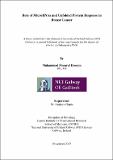| dc.description.abstract | Stressful conditions of the tumour microenvironment which overwhelm the folding capacity of the endoplasmic reticulum (EnR) activate an evolutionary conserved signalling pathway known as the unfolded protein response (UPR). UPR is mediated by three molecular sensors, PKR-like ER kinase (PERK), activated transcription factor 6 (ATF6), and Inositol-requiring enzyme 1 (IRE1) present in the membrane of the endoplasmic reticulum. UPR signalling pathway exhibits both tumour-supporting and tumour-suppressive roles to modulate their function during cancer development. This imposes a big challenge for the development of cancer therapies that target UPR pathway. Work presented in this thesis describes the interplay between UPR pathway and estrogen signalling in estrogen receptor-alpha (ER)-positive breast cancer and role of UPR-regulated miRNAs in breast cancer. Invasive breast cancer is a heterogeneous disease with varied molecular features, behaviour and response to therapy. The Cancer Genome Atlas consortium reported that most dominant feature of ER-positive breast cancers is increased mRNA and protein levels of ESR1, GATA3, FOXA1, XBP1 and MYB. Several studies indicate a crucial role for the IRE1-XBP1 arm of UPR in several aspects of ER-positive breast cancer. The expression of XBP1 is induced by estrogen stimulation. XBP1 physically interacts with ER and potentiate ER-dependent transcriptional activity in a ligand-independent manner. Ectopic expression of XBP1 in ER-positive breast cancer cells can lead to estrogen-independent growth and reduced sensitivity to anti-estrogens. Unlike IRE1-XBP1 axis, not much is known about the role PERK and ATF6 sensors of UPR during estrogen signalling.
The chapter 3 of the thesis reports the crosstalk between UPR and estrogen signalling. In this study, we demonstrate that induction of nuclear receptor coactivator 3 (NCOA3) is regulated by XBP1 during UPR, as well as estrogen stimulation in human breast cancer cells. NCOA3 is required for induction of XBP1 upon estrogen stimulation and XBP1-mediated endocrine resistance in ER-positive breast cancer. Further, we show that NCOA3 regulates the expression of PERK. Our results show that NCOA3 regulates optimal activation of PERK pathway during conditions of UPR. We show that loss of NCOA3 renders cells hypersensitive to UPR induced cell death. Our results show that hyperactivation of NCOA3 by MCB-613 leads to enhanced PERK signalling and knockdown of PERK provided resistance to MCB-613 mediated cell death. Taken together our results point to NCOA3 as an important determinant in regulating cell fate during EnR stress, with too little and too much NCOA3 both producing deleterious effects.
This thesis describes the functional characterization of two UPR regulated miRNA clusters namely, miR-17-92 cluster and miR-424(322)-503 cluster. The miR-17-92 is an oncogenic miRNA cluster that generates six mature miRNAs: miR-17, miR-18a, miR-19a, miR-20a, miR-19b and miR-92a. Amplification of 13q31-q32, which is the locus of the miR-17-92 cluster, have been reported in haematopoietic malignancies, such as B cell lymphoma. In contrast, MIR17HG was deleted in 21.9% of breast cancers and loss of heterozygosity at 13q12-q13 was associated with poor prognosis in breast cancer. The chapter 4 of this thesis describes that expression of MIR17HG is increased in tissues and cell lines from triple negative breast cancer (TNBC) but decreased in the tissues and cell lines from the estrogen receptor (ER)-positive breast cancer. Our results show that ectopic expression of miR-17-92 cluster significantly supressed cell proliferation, colony formation, migration and invasion of ER-positive (MCF7, T47D) and HER2-enriched (SKBR3) cells whereas it enhanced cell proliferation, colony formation, migration and invasion in TNBC (MDA-MB 231) cells. Further, we found that expression of miR-17-92 cluster sensitized MCF7 cells whereas it rendered SKBR3 cells resistant to chemotherapeutic compounds. Higher expression of five miRNAs of this cluster was associated with better overall survival (OS) in (miR-17, miR-19a, miR-20a, miR-19b and miR-92) Luminal A subtype whereas three miRNAs of this cluster were associated with poor overall survival (OS) in (miR-17, miR-18a and miR-92) HER2-enriched and (miR-17, miR-19b and miR-92) TNBC subtypes. Further, we identified ADORA1, H19, CENPV and PREX1 as the potential targets of miR-17-92 cluster in MCF7 cells. Taken together our results suggest that miR-17-92 cluster acts as a tumour suppressor in ER-positive and HER2-enriched breast cancer cells but shows oncogenic role in TNBC.
Global approaches in several cellular contexts have revealed that UPR pathway regulates the expression of many miRNAs that plays an important role in the regulation of life and death decisions during UPR. The locus of miR-424(322)-503 cluster is deleted in approximately 14% of breast cancer and this deletion is associated with the reduced expression level of mature miR-424 and miR-503. Deletion of miR-424(322)-503 cluster promotes breast cancer and provides chemoresistance against anti-cancer therapy. The chapter 5 of this thesis describes that expression of miR-424(322)-503 cluster is repressed in a PERK-dependent manner. We show that miR-424 decreases the UPR-mediated activation of transcriptional activity of ATF6 and enhances the RIDD activity of IRE1. Further, we show that miR-424 reduces the expression of ATF6 acting via a miR-424 binding site in the 3' UTR of ATF6. Taken together, our study reveals a novel function of PERK in the regulation of ATF6 activity and RIDD activity of IRE1 through miR-424(322)-503 cluster. | en_IE |


